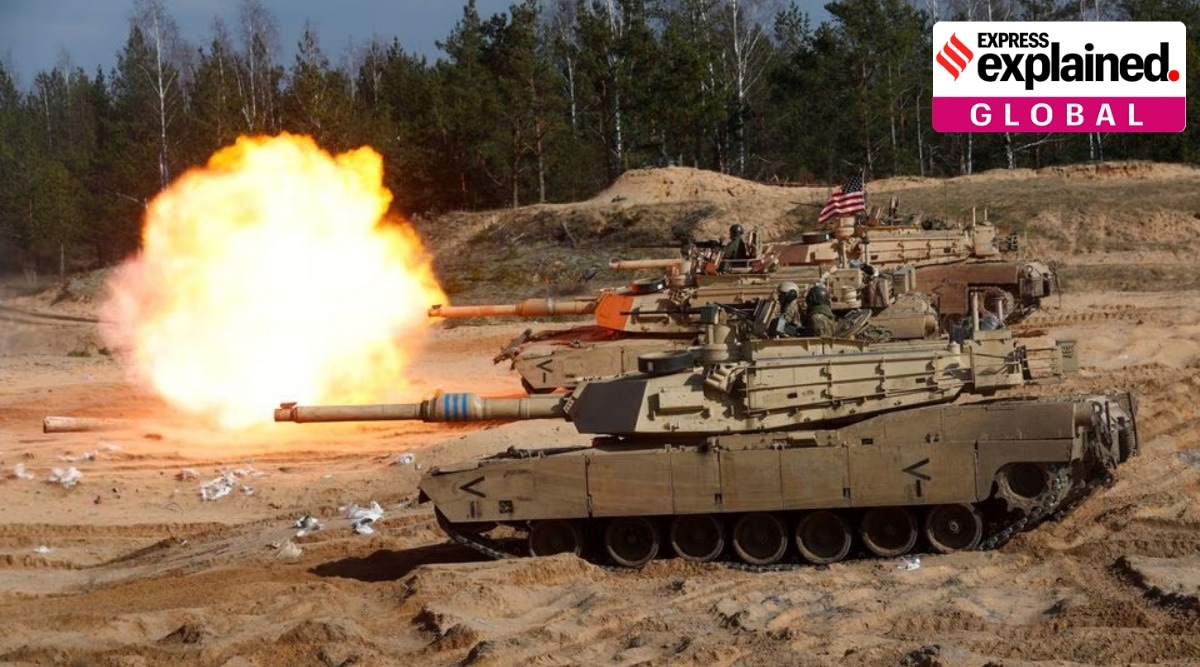
The American M1 Abram tanks are amongst the most advanced battle tanks in the world, combining speed, strong armour with massive firepower. However, the quality comes at a cost: these tanks are expensive as well as requiring deep technical know-how to operate (Reuters/Ints Kalnins)
After months of mounting pressure, the United States and Germany agreed to send tanks to Ukraine on January 25. While the Americas will supply 31 M1 Abrams tanks, Germany will send 14 Leopard 2 tanks, Reuters reported.
President Joe Biden, while announcing the decision at the White House, said, “[Russia’s President Vladimir] Putin expected Europe and the United States to weaken our resolve. He expected our support for Ukraine to crumble with time. He was wrong.”
Ukraine’s President Volodymyr Zelensky said that the move by the two Western countries is an important step towards ensuring Ukraine’s victory against the Russians. “Today the free world is united as never before for a common goal — liberation of Ukraine,” he said.
Russian officials have condemned the US and German announcements as a “blatant provocation”. Kremlin spokesman Dmitry Peskov said sending the Abrams would be a waste of money because “These tanks burn like all the rest. They are just very expensive.”SUBSCRIBER ONLY STORIESView All
According to The New York Times, Zelensky and his senior-most military commander, General Valery Zaluzhny, believe that with an anticipated Russian springtime offensive just around the corner, to not only defend itself but also “make a difference” in its effort to reclaim the lost territories.
Before the US and Germany, the United Kingdom agreed to send 14 Challenger 2 tanks to Ukraine. France has also announced plans to give its AMX-10 RC light combat tanks to the country.
The American and German tanks
Both the M1 Abrams and Leopard 2 are considered state-of-the-art battle tanks that are more powerful than the Soviet-era tanks that Russia and Ukraine currently have.ADVERTISEMENT
The Abrams is the main battle tank of the US and was first delivered to its forces in 1980. Weighing around 67 tonnes, it can accommodate a crew of four personnel, including the driver. The tank has a sophisticated Chobham composite armour that protects it against any direct fire. It has a maximum speed of 67.5 km/h and a range of 1,005 km. The armaments include M256 120 mm smoothbore cannon, 12.7 mm machine gun and 7.62 mm M240 machine gun.
The powerful jet engine of the Abrams that “can propel the tank through almost any terrain, whether heavy snow or heavy mud”, according to an AP report.
However, all these come at a cost. Abrams tanks require extensive training to operate and are difficult to repair. The AP report said that these tanks “burn through fuel at a rate of at least two gallons per mile (4.7 litres per km), whether the tank is moving or idling”.ADVERTISEMENT
“The Abrams tank is a very complicated piece of equipment. It’s expensive, it’s hard to train on…It is not the easiest system to maintain. It may or may not be the right system,” the US under secretary of defence for policy, Colin Kahl, had said recently.
The Leopard 2 is easier to operate and maintain, and requires a shorter training period. The tank has a diesel-powered MTU MB 873 engine and weighs 55 tonnes. It comes with armaments such as the 120 mm smoothbore cannon and a fully-digital fire-control system.
Implications for of Ukraine and the war
Although the US and Germany have agreed to send their tanks to Ukraine, they might not have any immediate impact on the war, experts say. While it might take “many months” for the Abrams to be operational in Ukraine, the Leopard 2s will also not reach the battlefield before at least another two months. It is still unclear if these tanks would prove to be the gamechanger that they are billed to be.
“If Ukraine is going to have any chance of going on the offensive, they need some mobility with heavy guns — it’s not just enough to have military-grade Land Rovers or armoured patrolled vehicles. They need something that can actually destroy Russian tanks at a distance,” a diplomat from a EU country that is considering donating a number of modern battle tanks to Ukraine told POLITICO.
Analysts believe that the areas where tanks can be most effective are in southern Ukraine, where the land is flat. It is also where the Russian forces have built trenches and fortified bunkers. The Western tanks can easily trample them down, giving Ukraine the much-needed advantage in the war, they believe.
